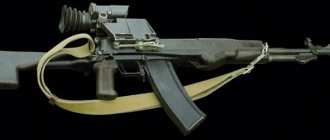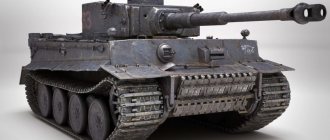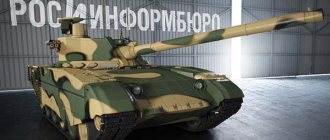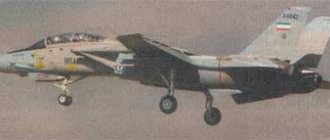Today, some weapons of the Russian Federation are superior to their foreign counterparts in many respects. Over the past three years, the army has received more than 20 thousand new models and approximately 2 million units of technical equipment. Russia's weapons are the guarantor of its sovereignty and the safety of its citizens. For the rest of the world, it is a guarantee of stability and peaceful resolution of controversial issues.
The new state program will operate until 2033 and focus on the further development of the most advanced technologies. It is planned to invest up to 22 trillion in AI alone. ₽ — with its help, scientists are trying to create autonomous combat units. Also important is the creation and development of new Russian nuclear weapons and deterrence systems.
Foreign partners have also noted a major breakthrough in this area. This is proven by the conclusion of contracts for the supply of advanced weapons worth several billion dollars in 2022. This primarily includes aircraft and air defense systems. In the near future, our country plans to provide the international market with new units of equipment manufactured using the latest technologies and based on new physical principles (NFP).
Space system "Tundra"
Russia has tested anti-satellite weapons . On November 25, a new military satellite, part of the Tundra system, was launched from the launch complex in Plesetsk using a Soyuz rocket. It is designed to monitor the launch of intercontinental missiles from the territory of a potential enemy, in particular the United States. Such a complex of several orbital units is capable of tracking launches not only from land, but also from the sea surface. It is understood that these Russian weapons in 2021 will replace the outdated Oko devices, naturally, over time. Tundra is controlled from the Central Command Post of the Ministry of Defense, and the system itself will consist of ten units of equipment in 2022.
ON THE TOPIC - “We have everything necessary to guarantee the protection of the country’s national interests,” - Vladimir Putin
Russia will test weapons in space . Together with this, our scientists are creating a mobile missile defense system S-550, which will have incomparable characteristics. The S-550 will be ground-based and will be capable of hitting long-range targets. Such as intercontinental ballistic missiles, satellites, X-37 drones, which have the ability to carry low-power nuclear missiles on board.
On November 15, Russia’s “anti-satellite” weapons perfectly accurately hit a target at an altitude of 500 kilometers above sea level - the old Soviet spacecraft Kosmos-1408. This caused a great stir in society, and our “partners” realized that their space program could be under threat, since the S-550 is capable of hitting targets at great distances. Disturbances in the operation of American GPS satellites can “blind” US and NATO ships, aircraft. Then their troops will have to pick up paper maps again.
What is known about Russian and American hypersonic weapons
What are hypersonic weapons?
These are the latest systems capable of traveling at speeds significantly greater than the speed of sound - 6,000 km/h.
This makes such weapons invulnerable to modern missile defense systems, no matter how technologically advanced they may be. Another important advantage of hypersound is that it significantly reduces the time for making a decision on a retaliatory strike. In conditions where all strategic command is confined to the head of state, the possibilities for an effective response are significantly reduced.
Until recently, in the context of the dominance of nuclear weapons, states defended their territories with the help of a missile defense system, which includes detection and warning systems and the missile defense systems themselves. The task of a missile defense system is to destroy an enemy warhead before it hits the target.
The problem is that even the most modern missile defense systems are designed for missiles flying along a ballistic trajectory. Their flight is calculated: the location of a hypothetical strike from a potential enemy is calculated, after which forces sufficient to repel the attack are concentrated there.
This does not work with hypersonic weapons. Its speed, many times greater than the 5,000 km/h mark, leaves no time to react accordingly. The use of hypersonic weapons makes it possible to destroy the nuclear shield of any enemy in a matter of minutes without the threat of retaliation.
Thus, the nuclear arsenals accumulated by some world powers are simply becoming useless. The invulnerability and colossal speed of hypersonic weapons is what makes them more dangerous than nuclear weapons. In addition, not a single, even the most powerful, computer is capable of calculating the constantly changing trajectory of hypersonic missiles.
The disappearance of the deterrent factor in this case sharply increases the likelihood of a preventive attack. There may be a temptation to use hypersound to deliver a quick and effective strike and disarm the enemy in order to force him to terms favorable to himself.
The first thing that catches your eye is the nose. We are accustomed to the fact that all existing missiles, be it intercontinental or tactical, have the appearance of a sort of “sharpened pencil”. And the hypersonic one resembles a giant shark with a cut off nose.
How did the US-Russia conflict over weapons begin?
US President Donald Trump said on September 19 during a campaign rally in Minnesota that Russia created its hypersonic weapons based on information stolen during the administration of his predecessor Barack Obama
Trump reminded his supporters that Russia has a "super-duper-hypersonic missile" that reaches speeds five times faster than a normal one. According to him, the United States has a missile that flies at a much higher speed
But Russia received this information (about hypersonic missile technology) from the Obama administration, Russia stole this information. Did you know about this? Russia received this information and then created it.
Donald Trump, US President
On the same day, Russian President Vladimir Putin, in honor of Gunsmith's Day, spoke via video link with the developer of the Avangard system missiles, honorary general designer of NPO Mashinostroeniya, Herbert Efremov.
During this conversation, he stated that Russia was forced to begin developing hypersonic weapons due to the US withdrawal from the Anti-Ballistic Missile Treaty in 2002. According to him, large-scale work began in 2004. Then the President of the United States was George W. Bush, Obama's predecessor and a Republican just like Trump.
The US withdrawal from the ABM Treaty in 2002 forced Russia to begin developing hypersonic weapons. We had to create these weapons in response to the US deployment of a strategic missile defense system, which in the future would be able to actually neutralize and nullify our entire nuclear potential.
Vladimir Putin, President of Russia
What else is important to know?
Avangard are Russian hypersonic missiles that, according to the Russian president, travel at 27 times the speed of sound. Putin first mentioned them in December 2018, and then stated that such Russian weapons help maintain strategic balance and stability in the world.
Trump talked about a "super-duper rocket" that is 17 times faster than anything else in existence in May. The Pentagon later clarified that the US President was referring to the March tests, during which the rocket's speed was 17 times the speed of sound. At the same time, according to CNN, US developments are inferior to Russian or Chinese ones, and they are unlikely to enter service before 2023.
And what does Herbert Efremov, who personally came up with the idea of creating the Avangard hypersonic unit, say?
The former general director of the military-industrial corporation NPO Mashinostroyenia Herbert Efremov gave an interview where he spoke in more detail about his work.
The work of Herbert Efremov was classified for more than 60 years. He started as an engineer at one of the leading rocket and space companies of the USSR and Russia (OKB-52 of the USSR Ministry of Aviation Industry, now the military-industrial complex NPO Mashinostroeniya), where satellites and manned spacecraft were developed. The general designer, and later the general director of the NPO, Efremov participated in the development of the UR-100 intercontinental ballistic missiles, the Almaz manned orbital station, the naval space reconnaissance system and the Proton series of scientific laboratory satellites. The Bastion missile system, which was used by Russia in Syria, was also created under the leadership of Efremov. Since 2007, the designer has held the position of scientific advisor at the NPO.
According to Efremov, Vladimir Putin set the task of creating Avangard as a combat system in 2004. But experiments have been conducted since the 1980s, during an active conflict with America.
Experts believe that the Avangard will be very noticeable because during flight it will heat up to very high temperatures and will glow in the infrared range. To this Efremov replied that, despite appearances, it would be impossible to hit the rocket in any case due to its high speed.
Another critic of the Russian hypersonic missile, engineer Andrei Gorbachevsky, in a conversation with Novaya Gazeta, claims that when approaching the target, the Avangard’s speed will already be lower than hypersonic, including due to maneuvering.
Another Russian development that was tested on October 6 is the Zircon hypersonic cruise missile.
Yesterday at 7:15 a.m., from the White Sea, the frigate Admiral of the Fleet of the Soviet Union Gorshkov fired a hypersonic Zircon cruise missile at a sea target located in the Barents Sea for the first time as part of flight tests.
Valery Gerasimov, Chief of the General Staff
"Zircon" (3M22) belongs to the category of hypersonic weapons. On its trajectory, it is capable of developing enormous speed (about Mach 9). The Zircon hypersonic missile is positioned as an anti-ship missile. Today, there are no means in the world that could effectively intercept such types of weapons. It is also important to note that such weapons are available today only in the Russian Federation.
What weapons are there in the USA?
The Americans, in turn, continue testing the X-51A Waverider hypersonic cruise missile. True, its speed is significantly lower than that of the Avangard - no more than 7,500 km/h (about Mach 6).
The Pentagon plans to use the missile as part of a rapid global strike strategy, which envisions the ability to attack any target around the globe within one hour.
The main targets in Washington are North Korea and terrorist groups that can seize weapons of mass destruction. However, Russia and China believe that the latest American development may also be directed against them.
In the United States, hypersonic projects developed as part of the Prompt Global Strike initiative. At the same time, two competing developments were tested - Advanced HypersonicWeapon (AHW) and HypersonicTechnologyVehicle 2 (HTV-2). Of these, only one AHW test in 2011 was successful, although there is no detailed information about it. However, the last test launch in 2014 was unsuccessful.
It is also reported that the United States is collaborating with Australia as part of the HIFiRE (Hypersonic International Flight Research Experimentation Program) research project. Several launches of hypersonic aircraft have already been carried out, and in July 2022, the developers managed to reach a speed of Mach 7.5. Another hypersonic project, Tactical Boost Glide (TBG), developed on the experience of HTV-2 and funded by DARPA (Defense Advanced Research Projects Agency), has already spent $147 million.
What about the super super rocket?
The “super-duper missile,” the appearance of which was previously announced by US President Donald Trump, is a hypersonic missile AGM-183A, created in the interests of the American air force. This was stated by military expert and editor-in-chief of the Arsenal of the Fatherland magazine Viktor Murakhovsky.
He revealed the characteristics of the AGM-183A: it should reach a maximum speed of up to Mach 20, its estimated firing range will be about 900 km.
According to the expert, there is no breakthrough in such a rocket, since known materials and technologies are used in its creation. Essentially, it is an aeroballistic missile launched from an air carrier. It is accelerated by a solid fuel stage, and then the hypersonic unit itself flies along a ballistic trajectory, Murakhovsky described.
What's the result?
Let us note that in Russia they speak primarily about the nuclear equipment of hypersonic weapons, in the USA - about non-nuclear weapons, and in China they do not say anything directly. As for other countries, for example, in France, the next generation of nuclear-powered air-launched cruise missiles is planned to be hypersonic. It is possible that in the future the situation will change, and everyone will come to the “dual purpose” of hypersonic weapons.
For now, the most important task remains the promotion of arms control initiatives in the field of long-range precision-guided conventional weapons, which are strategic non-nuclear weapons. And “hyperhype” can be a good catalyst for such a discussion.
Read also
On the 3rd day of illness, most patients with COVID-19 lose their sense of smell and often suffer from a runny nose.
Animals are dying out en masse in Kamchatka. What we know about pollution in the Pacific Ocean
The Doomsday Glacier turned out to be more dangerous than scientists thought. We tell you the main thing
Hypersonic missile "Zircon"
Russia's tested weapon in the form of the Zircon hypersonic missile in 2022 showed excellent results. It reached hyperspeed and showed a flight range exceeding 1,000 kilometers. Launches were carried out from surface and underwater bases. Moreover, all targets located on the shore were hit in 4 minutes, which is quite fast.
ON THE TOPIC - Russia successfully tested the Zircon hypersonic missile
Elusive in every sense, the Zircon is planned to be put into service with the Russian Navy as early as 2022. In parallel, the development and production of a ground-based complex for greater mobility is underway.
The complex's destructive properties allow it to compete even with low-power nuclear weapons. This became possible due to the high kinetic energy that the rocket acquires in flight due to its high speed. The convection warhead of one unit is capable of hitting an aircraft carrier, large or medium-sized object on the ground.
ON THE TOPIC - The Russian Ministry of Defense carried out a test launch of the Zircon hypersonic missile from a submarine
America tried to develop its own models, but things did not go further than testing. Their prototypes refuse to fly “correctly”. In the Russia-US arms , our country is still several years ahead of its competitors in this area.
Visual-optical jamming station "Grach"
The ship station performs a protective function at night and twilight. Thanks to light radiation, the enemy is unaware of the location of the ship, and the crew can carry out combat operations, landing on the shore, and reconnaissance forays. Thanks to its design, the “Rook” can save the crew from targeted fire. The installation has no analogues in the entire military community.
Final testing and production of "Armata" and "Terminator"
Such news greatly saddens our “partners”. The production and commissioning of vehicles can be illustrated by the example of the 90th Tank Division. The first 10 units of equipment have already been delivered to the Central District.
The Terminator tank support combat vehicle is based on the modernized T-72 main battle tank. The latest changes have been made to the design taking into account combat experience in the Syrian Arab Republic. Tracked vehicles are capable of hitting infantry fighting vehicles and main battle tanks at a distance of up to 6 kilometers, as well as effectively fighting aircraft and low-flying targets.
This became possible thanks to the Ataka-T missile system, a coaxial 30 mm 2A42 cannon, two AG-17D grenade launchers and two 7.62 mm machine guns. The crew consists of five people.
The Russian Ministry of Defense also reported on the transition to final testing of the T-14 MBT. “Armata” is planned to be delivered to the troops starting in 2022, as they are now undergoing a “baptism of fire” in Syria. As of today, the army has already received a small experimental batch of these vehicles in the amount of 20 units.
Many experts believe that this new Russian weapon will be about 30% more effective than the MBT of a potential enemy. Such indicators consist not only of combat power, but also of material costs, armor, maneuverability, and speed indicators.
ON THE TOPIC - A photograph of the newest Russian military aircraft is presented
The vehicle is equipped with a 125-mm cannon capable of firing up to 12 rounds per minute while moving. This is superior to all existing analogues today, including the Leopard-2A6 system with a caliber of 120 mm. The optical complex allows the crew to conduct targeted fire from the gun in any weather conditions. During the day this figure is 5 km, at night – 3.5 km. The device has a mass of 48 tons and can accelerate to 90 km/h. The engine used is a diesel power plant with a capacity of 1,500 horsepower, the service life of which reaches 2,000 hours.
T-14 Armata. Description and performance characteristics. No other tank in the WORLD has such features!
The crew consists of three people. They are located in an armored capsule, which significantly increases their safety. Soldiers are able to survive even after a direct hit from an ATGM or detonation of ammunition. The ammunition capacity is 40 shells for various purposes. The main gun is also capable of firing anti-tank guided missiles at the enemy. In the future, the complex can be transferred to remote control. This will allow the technology to work without direct human participation. Experts predict the superiority of the Armata until the 50s of the 21st century, since at the moment there are no analogues in the world.
Orion unmanned vehicle and Altius unmanned vehicle
Today, the Russian army already has about 2,000 UAVs at its disposal. By the end of 2022, it is planned to put into operation another 18 unmanned vehicles.
Orion is the first MALE class attack and reconnaissance drone. With a take-off weight of one ton, it is capable of carrying up to 200 kilograms of payload. The speed performance is also impressive: the maximum speed reaches 200 km/h, and the time it can spend in airspace is a day or more. The drone performed well in the Syrian Arab Republic, and today more than 15 foreign countries want to see it in their troops. It is capable of carrying various weapons and operating in the most extreme weather conditions (Arctic, Sahara). Today it is considered one of the most reliable UAVs in its class.
At the exhibition in Dubai, the Russian Federation also demonstrated to visitors other developments in this area. These are unmanned aerial vehicles "Grom", "Sirius", "Helios-RLD". Based on this, we can safely say that Orion is not an accidental success of our engineers and designers.
ON THE TOPIC - Video of the dress rehearsal of the parade in honor of Navy Day in St. Petersburg
The more powerful and heavier Sirius, created on the basis of Orion, has a take-off weight of up to 5,000 kilograms and is capable of staying in the air for up to forty hours without refueling. During this time, it covers up to 10,000 kilometers. The drone is controlled using a satellite system that can combine UAVs into groups.
The even heavier Altius-RU drone is superior to the American-made Reaper UAV in terms of non-stop flight time, combat load, visibility for radar systems and other parameters.
Just the other day, namely on December 14, 2022, a test of Russian weapons of this class was carried out. The updated S-70 Okhotnik UAV took off. It received a rectangular engine nozzle and new landing gear designed specifically for this model. This is all that we were able to see externally. Most likely, the main changes affected the electronics, and, consequently, the flight and combat characteristics were improved.
R-30 "Bulava-30"
Ballistic three-stage missile, 12 meters long, 2 meters in diameter. These missiles are installed on submarines in the missile defense system. Weapons are currently being tested. The range reaches 9000 kilometers. Can carry up to 10 nuclear units. There have already been 26 rocket launches, 18 of which were successful.
Technology based on new physical principles in Russia
Since 2022, laser Peresvets began to arrive in various military units. This technique is based on completely different physical principles of influence. At the end of 2022, mobile systems were adopted by the Russian Federation. Today, little is known about the capabilities of this system, but there are rumors that the equipment is being tested in Syria. The details were not specified, but the media stated that in May the Peresvets underwent a “baptism of fire” in the Syrian Arab Republic.
Our scientists also made a major breakthrough in the field of electromagnetic technology. Such devices affect enemy electronics, disabling them. Recently, a project called “Alabuga” was actively discussed. It was originally the latest concept of an electromagnetic emitter. Subsequently, it became known about the development of a full-fledged pulse generator that could be installed on different media. Such equipment will have to be mounted on missiles to deliver an EMP generator to the combat area to disable all enemy electronics. But this information is unconfirmed, and it is too early to talk about the arrival of equipment to the troops. However, a vehicle based on similar principles already exists and is being used by the Strategic Missile Forces. This is the “Foliage” remote demining device. It is based on the principle of the propagation of microwaves, which detonate a mine at a distance of several tens of meters.
ON THE TOPIC - Russia will soon put new unique weapons systems on combat duty - Vladimir Putin
You can also note the rail gun, which accelerates the projectile to very high speeds due to magnetic influence. Information about testing and implementation of this principle has not yet been confirmed.
This category includes complexes that are built on the basis of the effects of sound vibrations, geophysical influences, genetic developments, etc.
Hypersonic aircraft Yu-71
This aircraft is capable of reaching speeds of about 11,000 kilometers per hour. It is invulnerable to missile defense systems. Based on the Yu-71, they plan to use the Sarmat ICBM, which together represents a fifth-generation superweapon. The device uses a gliding type of flight and is very maneuverable.
At the Yu-71 base, electronic warfare systems can be installed, which in a few minutes of flight of the device can disable all detection stations in the entire enemy state. Too few details about the device are still known, but it is already clear that this is a huge step in Russia’s armament.
Ballistic missile "Bulava"
Most recently, from the Sea of Okhotsk, the Borei class submarine Vladimir Monomakh launched four R-30 ballistic missiles at once.
ON THE TOPIC - Navy Day: Vladimir Putin hosted the Main Naval Parade | VIDEO
This showed our foreign “partners” our combat readiness. Currently, the Russian fleet has three submarine cruisers of this class: Vladimir Monomakh, Alexander Nevsky, and Yuri Dolgoruky.
Each of them carries on board up to 16 Bulava ballistic missiles. The boats differ from their analogues in lower noise, high maneuverability, and a more advanced weapons control system.
S-300VM "Antey-2500"
An air defense system that is capable of repelling ballistic missiles with a range of 2,500 kilometers, preventing threats from aircraft, reconnaissance and strike systems and cruise missiles.
The system simultaneously tracks 24 aerodynamic targets and 16 ballistic ones. It includes a command post, observation installations “Obzor-3” and “Ginger”, launchers and loading installations. Antey can be deployed in 5 minutes, which means high mobility and response speed.
Hypersonic missile "Avangard"
The Strategic Missile Forces received Avangard missiles at their disposal. They are equipped with a hypersonic unit that accelerates the warhead to a hypersonic speed of Mach 28, which is about 7.5 km/sec. Russian President Vladimir Putin compared the designers' project with a nuclear weapons project, which was first developed in the USSR.
The Ministry of Defense reports that when the missile enters dense layers, a significantly deviates from its ballistic trajectory. This makes it inaccessible to missile defense and air defense systems. The complex can also withstand very high temperatures. The warhead's yield can range from 800 kilotons to 2 megatons of TNT.
T-14
A tank based on the Armata platform. The vehicle simultaneously acts as fire correction, reconnaissance, and target targeting. This tank can distort its shape in enemy surveillance and reconnaissance systems. Equipped with Afghanit with super protection against anti-tank guns.
The tank's armor cannot be penetrated by modern missiles. Works at the tactical level, which is informed through a unified information support. At its base it has a smoothbore cannon and machine guns. It reaches a speed of 60 kilometers per hour on rough terrain, and the vehicle weighs about 48 tons.
Fifth generation military aviation in Russia
At the end of 2022, the VKS forces received a new 5th generation fighter SU-57. The first flight tests took place back in 2010.
The PAK FA is designed to destroy various targets: ground, surface, air. Most likely, over time it will replace the heavy SU-27 fighter.
ON THE TOPIC - Vladimir Putin at the opening of MAKS-2021 announced the great potential for the development of Russian aviation
President Vladimir Putin approved the purchase of 76 vehicles of this class by 2028. The device has very good flight characteristics, so the production of these machines will continue.
Update and modernization of the T-90 tank
Russian tank crews received a modernized vehicle - the T-90M Proryv. The first units of equipment began to arrive in military units at the end of 2022. The MBT received a V-92S2F diesel power unit. The installed 1,130 horsepower accelerates the car in a straight line to 60 km/h.
The Proryv was also equipped with a new turret and sight with multi-channel data transmission. Now the tank hits targets at any time of the day in any weather conditions. A system for exchanging information with other participants was also introduced. Communication allows a single piece of equipment to operate more efficiently.
Su-35
A highly maneuverable fighter designed for one crew. Put into operation in 2014, the cost of one Su-35 unit is more than 2 billion rubles. At altitude it can reach a speed of 2500 km/h.
On board are air-to-surface and air-to-air missiles, as well as 150-round cannon equipment. These fighters participated in Syria as cover aircraft. The length of the fighter is about 22 meters, and the wingspan is around 15 meters.
Pistol "Boa constrictor" instead of the pistol "Makarov"
Russian military personnel will receive a 9mm Boa Constrictor pistol. Its production began in 2022. He will replace the famous “veteran” PM. The development has several advantages compared to similar designs from famous manufacturers: CZ, Colt, Glock and Walther.
Cartridges with increased penetration power and, conversely, reduced bullet speed can be used as ammunition. The reinforced cartridge easily penetrates class 2 body armor. The design of the second reduces the noise level when firing using a silencer. A distinctive feature is a magazine with an indicator of the amount of ammunition in it.











